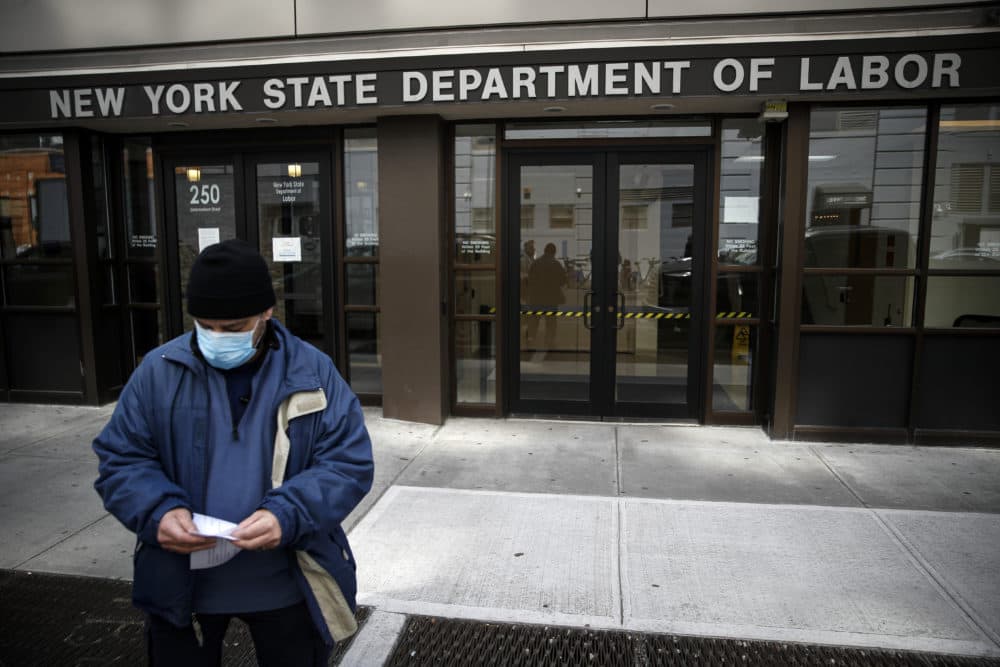Advertisement
Filing For Unemployment During The Coronavirus Pandemic? Here's What You Need To Know

During the last two weeks of March, the Department of Labor reported some 10 million Americans filed for unemployment — leading websites to crash and phone lines to clog up.
Andrew Stettner of the Century Foundation says states need to increase their bandwidth. He recommends quickly training people on simple problems like resetting passwords and leaving the difficult issues to seasoned employees.
It’s not too late for states to change their unemployment systems, he says. For example, states can translate more pages into Spanish and other languages or make it easier to file the application from a smartphone.
“Unfortunately, when they designed these systems, they don't take a customer-centered approach generally,” he says. “Understand your customers and the challenges that they have.”
Andrew Stettner’s Unemployment Filing Tips
Know If You're Eligible
Unemployment benefits are normally available to workers who receive paychecks or W-2s, have been at the job for at least six months and are unemployed through no fault of their own. This includes workers who still have their positions but aren’t given any hours, he says.
The CARES Act includes people the old system misses like workers who are newer to their jobs, self-employed or in the gig economy.
“If those individuals are unemployed because of COVID-19, Congress has given them a new special benefit through the end of this year,” he says.
If a worker is furloughed or has their hours cut back, they can collect unemployment. That’s been the case since 1935 when the law was passed, he says.
Understand The Benefits
Unemployment benefits vary state by state. Typically, workers receive half their prior paycheck, he says, but the maximum amount can vary from $250 to $1,000 per week.
But over the next four months, Congress is increasing everyone’s benefits by $600 per week. This benefit will backdate to March 27 for eligible workers who couldn’t immediately file for unemployment.
“Most workers should be expecting basically to maintain their pay over the next four months,” he says.
Get Your Materials Together
Before making a call to the unemployment office or opening the online application, Stettner suggests gathering everything you need to file. This includes your Social Security number, work history, W-2, pay stubs and any communication via email or text from your employer on your last day.
Self-employed people should have tax returns, a Schedule C form or any other evidence that proves you’re a regular worker, he says.
Stettner also recommends spending time reading the unemployment website before starting the application.
“I will commend states for putting out some pretty good information about the process and how to answer some of the tricky questions on the application,” he says. “So spend some time with the instructions.”
File ASAP — And Be Persistent
With the number of jobless claims breaking records, people all over the country are facing busy lines and crashing websites as they try to file for unemployment.
Experts like employment attorney Maria Passarelli at Cozen O'Connor emphasize the importance of filing as soon as possible. Stettner recommends trying at different times of the day and staying persistent.
Many states are using systems from the 1970s or 1980s, he says, and many of the newer websites are also having problems. His organization has talked with people in New York who say they’ve called hundreds of times, he says.
“You see that creaky car on the road with some rust around the tires. That was the unemployment system going into this crisis,” he says. “And now everybody in America is trying to jump into that vehicle.”
Francesca Paris produced and edited this interview for broadcast with Tinku Ray. Allison Hagan adapted it for the web.
This segment aired on April 7, 2020.

